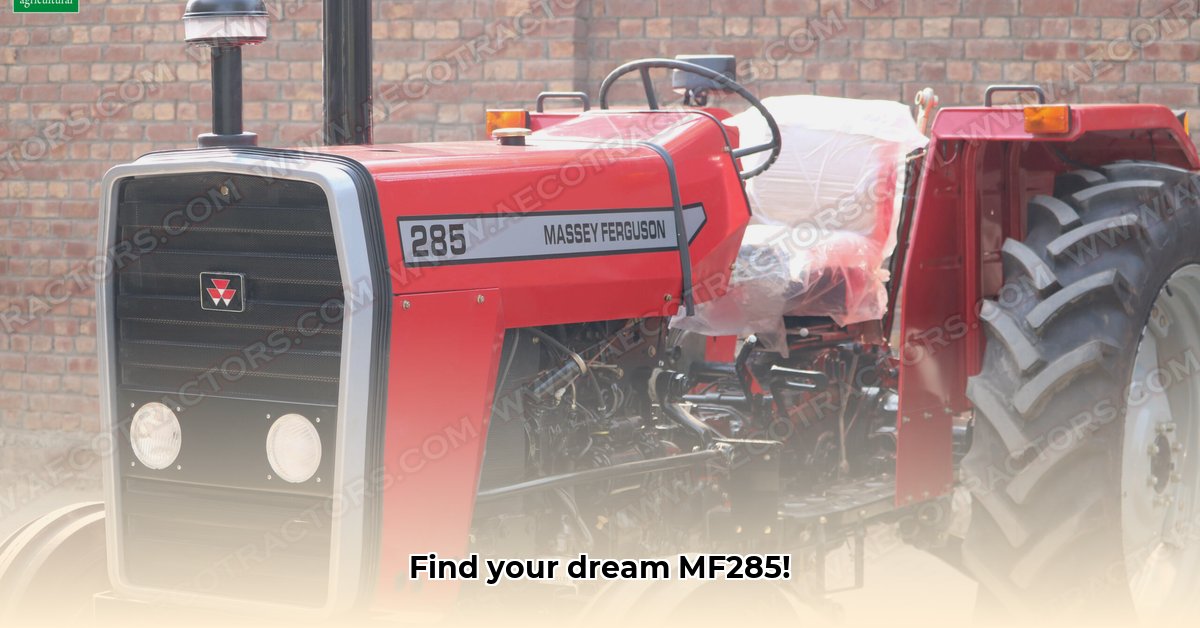
285 Massey Ferguson Tractor: Your Guide to Finding the Perfect Match
The Massey Ferguson 285, a robust and reliable workhorse, remains a popular choice among farmers and enthusiasts. This guide helps you navigate the process of finding the perfect MF 285, whether you're a seasoned professional or a first-time buyer. It covers everything from determining your needs to negotiating the final price. Are you ready to find your ideal classic tractor? For more information on Massey Ferguson tractors in general, check out this helpful resource: Massey Ferguson info.
Figuring Out Your Needs: Defining Your 285 Use Case
Before beginning your search, consider how you'll use the MF 285. Will it tackle light chores, heavy fieldwork, or something in between? This directly influences the tractor's required condition. Are you seeking a historical piece or a dependable work machine? This crucial question shapes your entire search strategy.
For example, a small orchard requires different capabilities than a large field. A lightly used 285 might suffice for the orchard, while a well-maintained, heavily used one is better suited for extensive fieldwork. The scale of your operations, including terrain (flat land versus hilly terrain), significantly impacts your needs.
Decoding the Market: Understanding MF 285 Pricing
The MF 285 market is diverse. Prices depend on condition, hours of use, included equipment (like a front-end loader), and location. Expect a wide range, from budget-friendly options to higher-priced, meticulously maintained tractors. Online marketplaces, auctions, and local classifieds are valuable resources. Remember: thorough research and patience are key. Don't rush into a purchase!
Pre-Purchase Inspection Checklist: A Crucial Step
Buying a used tractor is a significant investment, necessitating a thorough inspection. This checklist highlights essential areas to scrutinize:
Engine Health: Inspect for oil, fuel, and coolant leaks; listen for unusual noises; and observe the exhaust for excessive smoke. A smoky exhaust might indicate internal engine problems.
Hydraulic System: Check for leaks and ensure smooth operation. Sluggish response suggests potential problems.
Transmission: Shift through all gears; a smooth shift is ideal. Stiff or grinding gears indicate wear and tear.
Electrical System: Test lights, gauges, and the starter. A faulty system severely limits functionality. Check the battery condition as well.
Body and Structure: Inspect for rust, damage, dents, and signs of past repairs. Poorly executed repairs are a red flag.
Service History: A detailed service history is invaluable, providing insight into previous maintenance and repairs.
Drive System Selection: Two-Wheel or Four-Wheel Drive?
The MF 285 was available in two-wheel and four-wheel drive. Four-wheel drive offers significantly improved traction, particularly on hills or wet terrain. Two-wheel drive might suffice for flat, dry land applications and often comes at a lower purchase price. Choose the drive system that best suits your typical working conditions.
The Total Cost of Ownership: Beyond the Initial Purchase Price
Remember that ongoing maintenance and repairs are inherent costs of owning a classic tractor. While the initial purchase price is important, budget for parts, servicing, and potential major repairs or restorations. Unexpected issues can quickly deplete your funds if not adequately accounted for.
Weighing the Pros and Cons: Is an MF 285 the Right Tractor for You?
| Advantages | Disadvantages |
|---|---|
| Robust and reliable construction | Requires regular maintenance; potential for expensive repairs |
| Powerful for its era | Parts availability might be limited |
| Generally more affordable than a new tractor | Expected wear and tear due to age |
| Supportive online community | May lack advanced features of modern tractors |
| Relatively simple mechanical design | Fuel efficiency may be lower than newer models |
Securing the Deal: Tips for a Smooth Transaction
Negotiation: Negotiate the price, especially if you identify mechanical issues or signs of neglect.
Professional Inspection: Consider hiring a qualified mechanic for a pre-purchase inspection. This can prevent costly surprises.
Thorough Test Drive: Conduct a comprehensive test drive under realistic operating conditions.
Accurately Assessing Fair Market Value: A Step-by-Step Approach
Determining the fair market value of a used MF 285 requires careful consideration of several factors. Online valuation tools provide a starting point, but a comprehensive in-person inspection and local market research are crucial for determining a fair price.
Steps to Assess Fair Market Value:
Analyze Variables: Consider the year of manufacture, condition, location, and market demand.
Utilize Online Tools Cautiously: Use online valuations as a starting point, not as definitive values.
Conduct a Thorough Inspection: Perform a visual inspection, then enlist a qualified mechanic for a mechanical check and operational test.
Research Local Market Prices: Investigate local listings (online and offline) and talk to other farmers to gain insights into regional pricing.
Assess Restoration Quality: If the tractor is restored, carefully examine the quality of the work. Poorly done restorations will likely need repairs.
Negotiate the Price: Armed with your comprehensive research and assessment, negotiate a fair price for both parties.
Finding the right MF 285 requires patience and thoroughness. By following this guide, you’ll significantly increase your chances of acquiring a reliable and rewarding classic tractor. Remember that while this guide offers valuable insights, each transaction has unique aspects.